Amidst Wind and Sky: An Interview with Amanullah Mojadidi
Amanullah Mojadidi (born 1971 in Jacksonville) is an American conceptual artist and curator of Afghan descent. His parents left Kabul in the late 1960s, long before the country became a battleground of never-ending conflicts. His father’s eldest brother was Sibghatullah Mojadidi (1926-2019), who served as the acting president of Afghanistan for two months after the fall of the previous government in April 1998. One of three siblings, Amanullah is the only one who has ever visited Afghanistan. He wanted to connect with the birthplace of his ancestors.
For over 15 years, Mojadidi has worked as a conceptual artist in the field of art and culture within the international development sector. With a background in cultural anthropology, his research and artistic practice have used experimental ethnographic approaches and mixed-media techniques. Through site-specific installations and participatory performances, he approaches themes such as belonging, conflict, religion, identity, migration, and the politics of representation – often concerning Afghanistan. In 2012, Mojadidi was selected as a TED Fellow for the critical nature of his artistic practice while living in Kabul.
In 2010, Mojadidi created the satirical character “Jihadi Gangster” for a series of photos and posters. He dressed up as this character, whose appearance combined an American hip-hop gangster and a member of Afghan mujahideen. “Jihadi Gangster”-campaign posters began appearing alongside posters for factual candidates, with the slogan “Vote for me. I’ve done jihad. And I’m rich”.
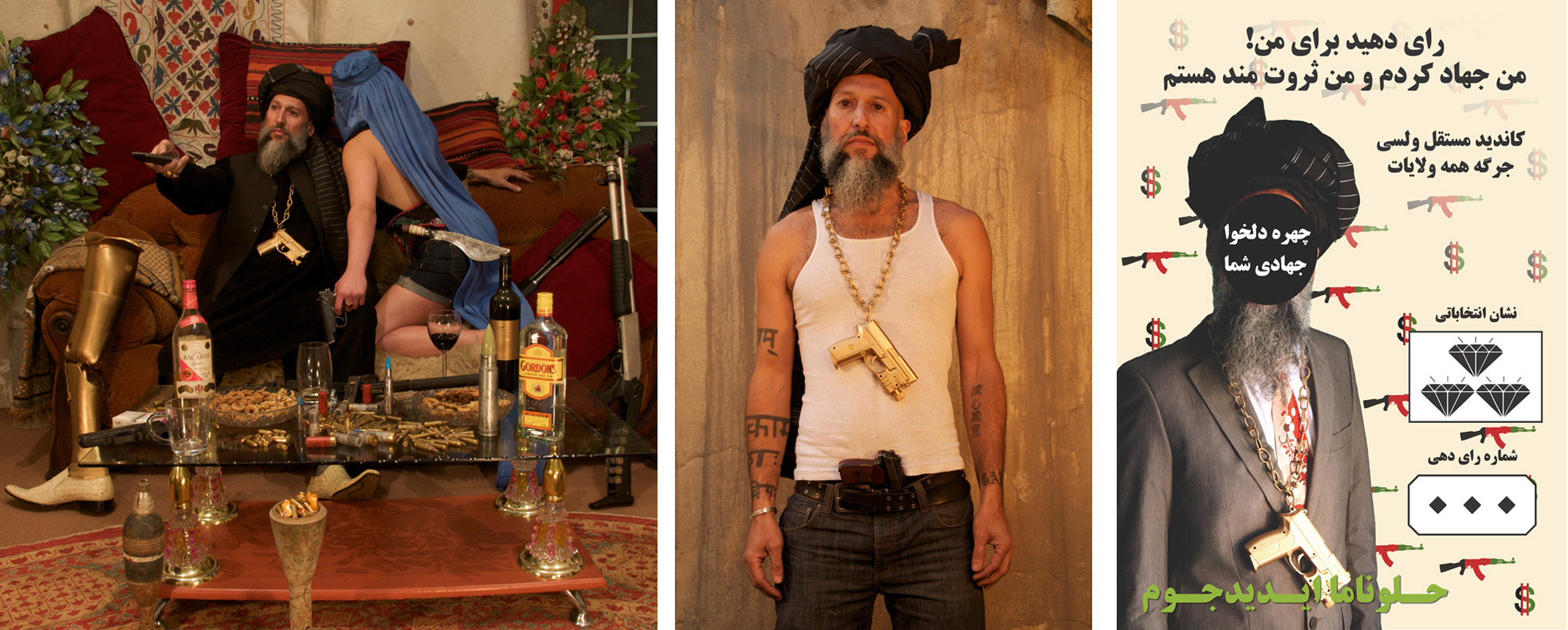
Amanullah Mojadidi © Courtesy of the artist: “Jihadi Gangster”-campaign posters
Mojadidi is currently based in Paris. His work has been shown internationally in several institutions and contemporary art exhibitions, such as the Imperial War Museums in Manchester (2014) and London (2018), dOCUMENTA 13 in Kassel (2012), the 12th Havana Biennial (2015), and the 3rd Art Summit in Dhaka (2016) and the 1st Kochi-Muziris Biennale in Kochi (2016). In 2024, he led a participatory performance in the temporary exhibition, “Stuttgart-Afghanistan,” at the Linden-Museum in Stuttgart. The resulting flag is now displayed as a site-specific installation in the permanent Orient exhibition at the museum.
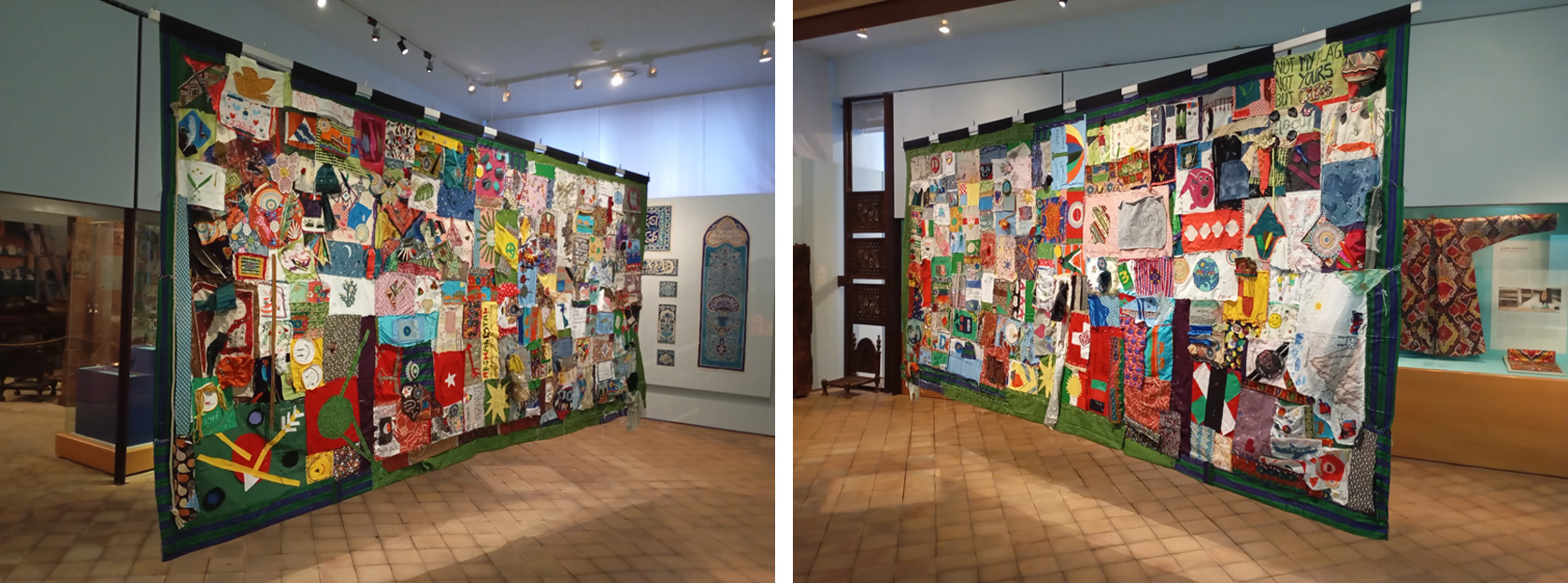
The new addition in the permanent exhibition at the Linden-Museum in Stuttgart is a fabric art installation made of woven stories and memories. Photos: Zeina Elcheikh ©
Stuttgart-Afghanistan: Connect, Tell, Encounter
The Linden-Museum in Stuttgart is one of Europe’s leading ethnological museums and has a special connection to Afghanistan. Between 27 January and 28 July 2024, the museum held a temporary exhibition “Stuttgart-Afghanistan”. Drawing a connection with previous wars and current conflicts, a primary focus was the Stuttgart-Badakhshan Expedition (1962-1963), the most significant and extended research trip in the Linden-Museum’s history. Members of the “Entangled: Stuttgart-Afghanistan” working group were actively involved in the planning and concept of the exhibition. Since 2019, the group has gathered participants from the Stuttgart region who relate to Afghanistan through lineage or academic work.
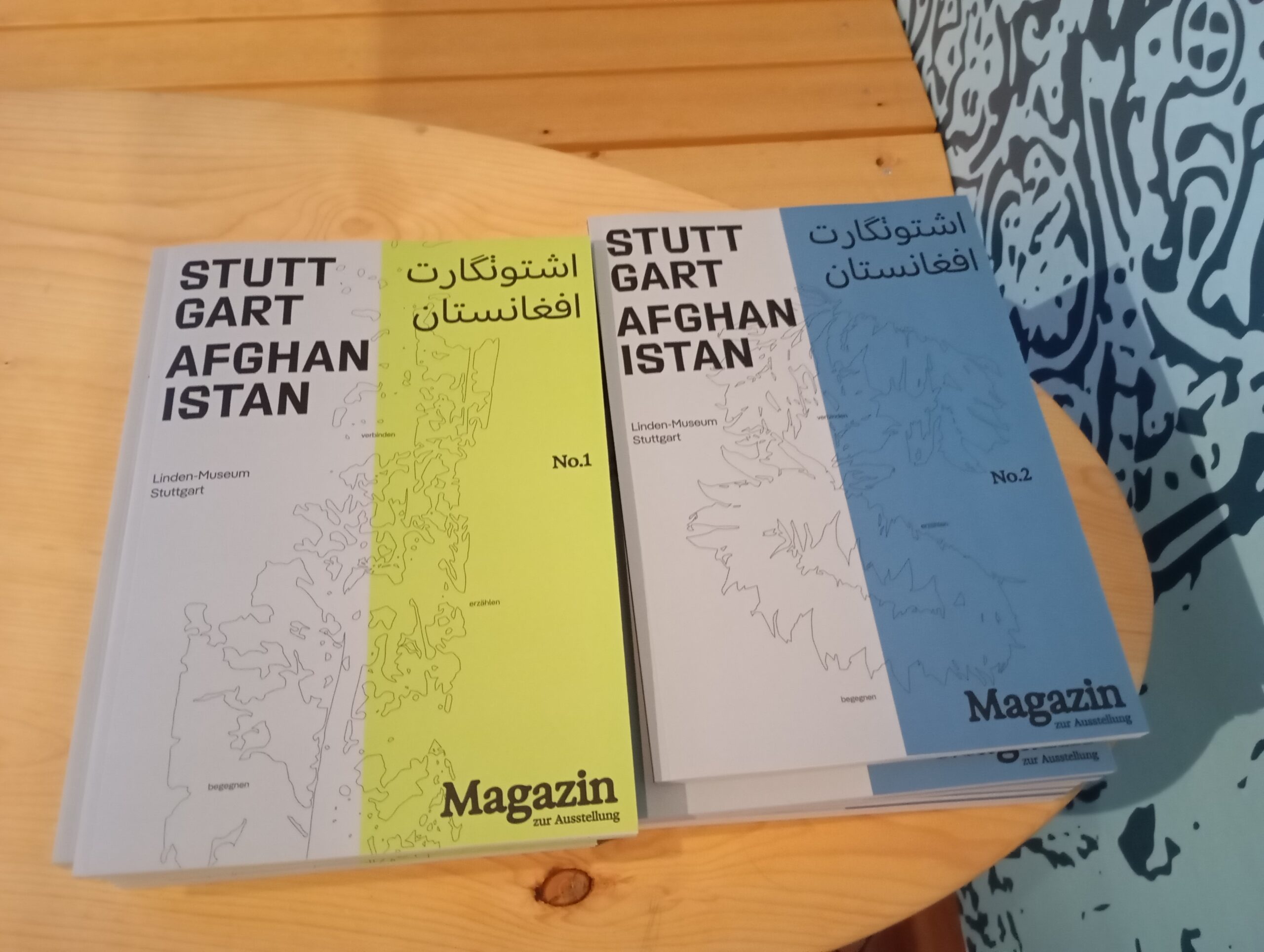
In addition to various artefacts and photographic materials, the exhibition Stuttgart-Afghanistan
offered a series of workshops, lectures, and guided tours. A special magazine was published
twice during the exhibition, offering interesting perspectives and deeper insights. Photo: Zeina Elcheikh ©
Moreover, individuals and groups of all ages and backgrounds creatively contributed to a participatory performance called “Amidst Wind and Sky,” which was led and directed by Amanullah Mojadidi. This project resulted in a flag that evolved over the months into a growing work of art, challenging contested narratives and standing as a symbol of belonging and community. The exhibition and the performance presented a more illustrious image of Afghanistan, which had been long forgotten by older generations and was almost unknown to younger ones.
Germany and Afghanistan: A long and multifaceted Connection
With its rugged landscapes and shifting borders, Afghanistan has a long history of domination and invasion by foreign conquerors and powers. However, no great power has been able to maintain stable long-term rule. The landlocked country is therefore known as the “Graveyard of Empires.”
As a bridge connecting Central and South Asia, Afghanistan was at the crossroads of the ancient trade routes that formed the Silk Road. From the historical region of Badakhshan, the precious stone lapis lazuli was mined and reached the Mediterranean world and Europe. Today, Afghanistan is one of the world’s leading refugee-producing countries.
The largest and oldest community of Afghans in Europe is in Germany, with migratory movements dating back to the first half of the 20th century. Between 1992 and 2002, Germany received the highest number of Afghan refugees and asylum seekers in Europe. This migration was subject to fluctuations strongly related to political and armed conflicts, such as the Mujahedeen’s fight in the Soviet-Afghan war, which continued after the Soviet withdrawal in 1989; the Afghan Civil War in the early 1990s; the rise of the Taliban in the mid-1990s; the US-led invasion in 2001; the reinstatement of the control of the Taliban in 2021 following the withdrawal of the US troops and their coalition partners.
After the fall of Kabul, Germany took in the largest number of Afghan refugees in Europe. This adds a new, however tragic, chapter to the long and multifaceted relationship between Germany and Afghanistan.
As a Flag Amidst Wind and Sky
The reasons why people flee their homes are often like the turbulent wind – an irrepressible force. Uprooted refugees and asylum seekers become like the sails on a ship – caught up in the wind, navigating towards a new destination without complete control over their course.
“Afghans have been spread around during the last years. A big evacuation movement has taken place since 2021, making them a flag blown away by the wind in the sky.” Amanullah Mojadidi
Flags are more than just pieces of fabric; they are powerful symbols. Depending on their role, they have many different shapes, colors, and names. Almost certainly invented by ancient Eastern peoples, flags have always served practical functions, such as providing visual references, giving instructions, and sending messages. They are undoubtedly cultural artefacts and tangible expressions of a society’s values, history, and identity. Moreover, they provide a sense of pride and unity among a country’s citizens. Flags bring people together to support their sports teams and celebrate their successes. While flags can transcend borders and promote a sense of community and togetherness, they can also be misused to spread blind patriotism, extremism, and division.
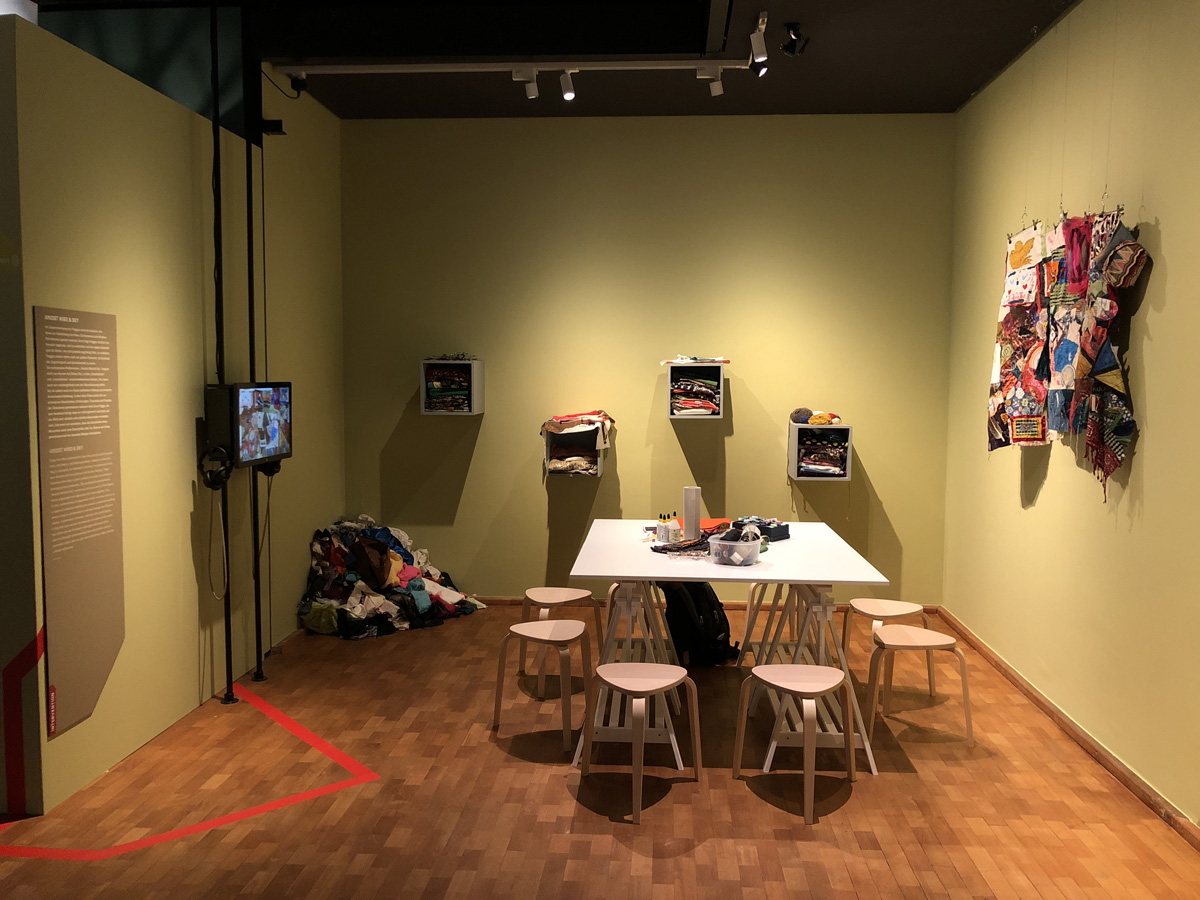
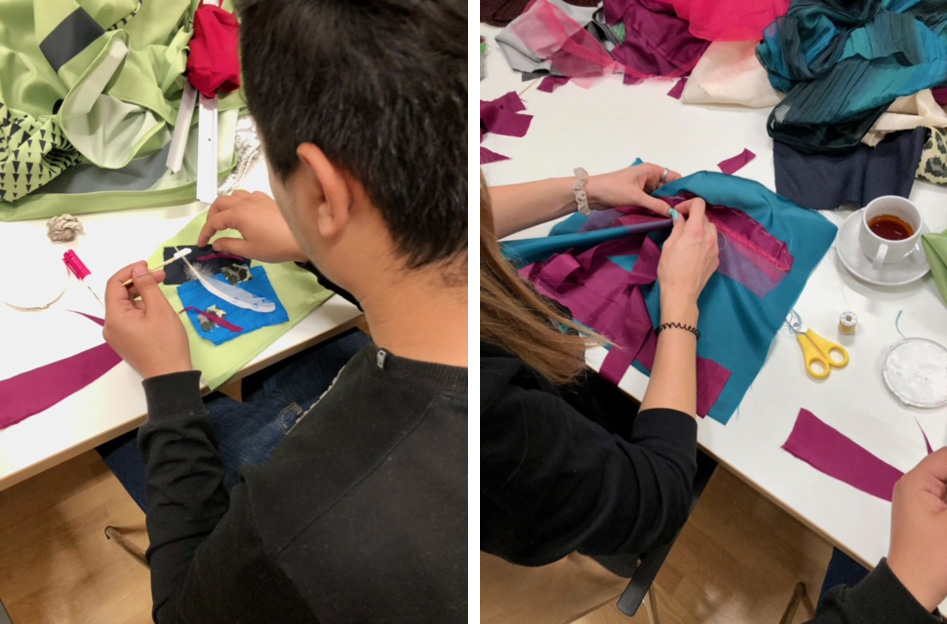
Participants of the workshops working in the Linden-Museum. Photos: Amanullah Mojadidi ©
While the project “Amid Wind and Sky” is a continuation of Mojadidi’s previous work, it was the first time he had worked primarily with fabrics and sewing, stitching, and tapestry techniques.
Initially, two workshops were planned with the “Entangled: Stuttgart-Afghanistan” working group. The museum’s education department engaged younger participants by inviting school classes, which added a new group dynamic. For Mojadidi, it was interesting to watch young people doing tactile work and actively participating in an exhibition-making process in a museum.
The workspace became a place to talk about the complex meanings of flags. These discussions were an integral part of the process, enabling visitors to share their thoughts on identity, culture, and belonging.
“As a message to young people: you belong exactly where you are.” Amanullah Mojadidi
The collaborative project encouraged the participants to become creators, allowing them to design and create their own miniature flags from fabric and other materials. It brought people of all ages and backgrounds together in a physical manifestation of their diverse experiences and stories: Older German couples, students, and newcomers worked together on the same project in the same place and at the same time. Language barriers and differences in origin began to disappear. While the project was a form of self-exploration for some participants, it was a healing process for others.
For Mojadidi, the process itself was the artwork. It kept evolving with the collective idea of the flag and the emerging community it was intended to represent. After the workshops ended, he needed a few days to work on his own, sewing and gathering everything by hand to create the final product: the flag.
“A flag that belongs to everyone, and everyone belongs to it.” Amanullah Mojadidi
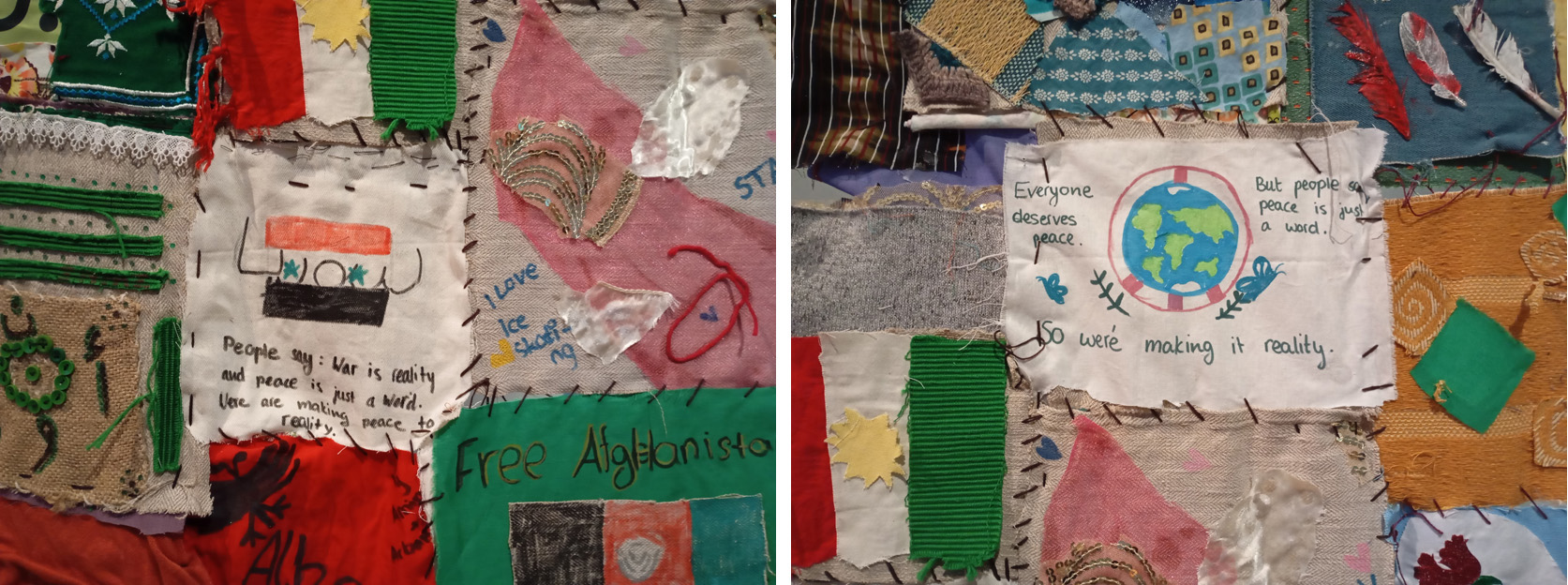
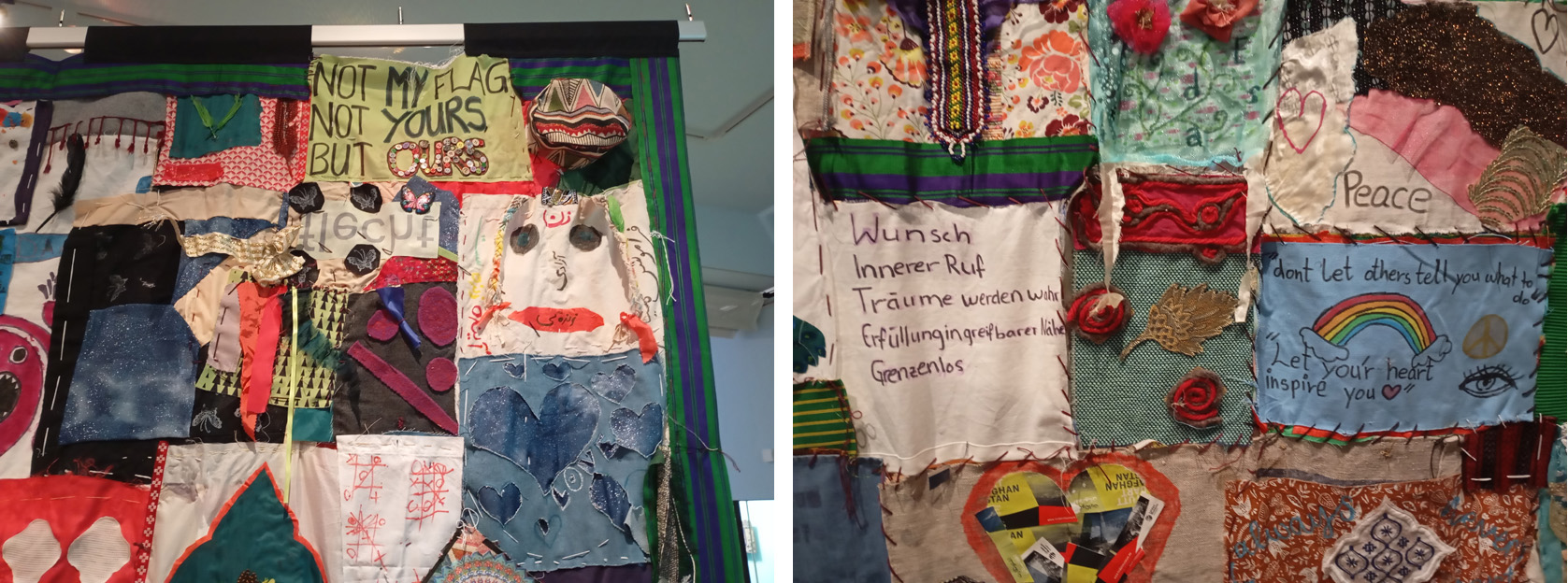
Details of the flag show contributions that include stories and memories from Afghan and Syrian refugees. Others feature motivational sentences or even the crest of a favorite football team. Photos: Zeina Elcheikh ©
The Museum as a Backdrop, the Flag as a Message
For Amanullah Mojadidi, the “Amidst Wind and Sky” project was not just another addition to his artistic career. He left Stuttgart with plenty of pleasant memories. The flag remains a unique installation and an artifactual memento in the Linden-Museum. It demonstrates that one person’s story could become the story of a community, and that what brings people together is stronger and bigger than what keeps them apart.
For those who lost their homes, there is not enough wind to blow hope away. And for those looking for a better future, there is not enough sky to cover with dreams.
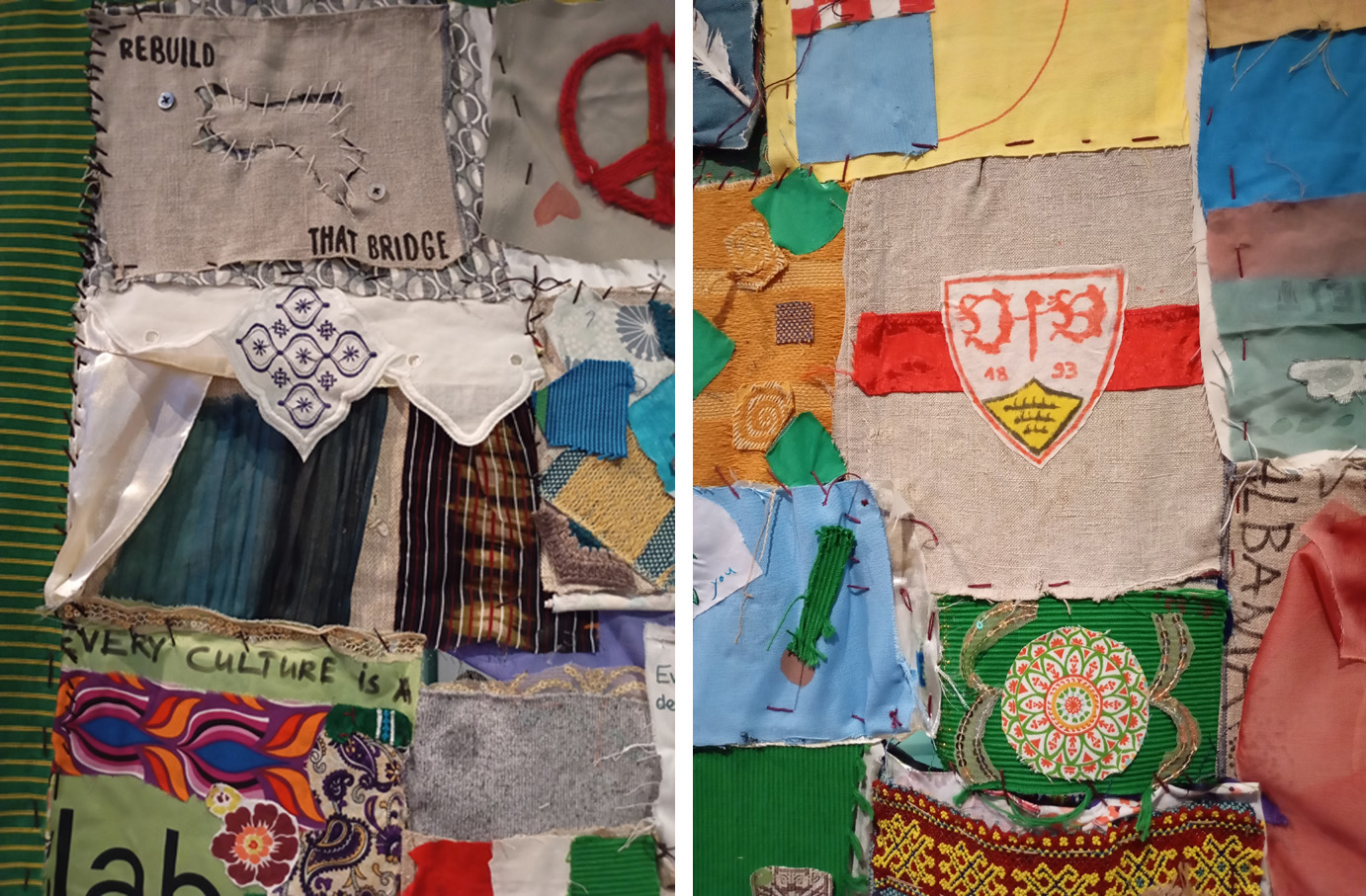
Details of the flag show contributions that include stories and memories from Afghan and Syrian refugees. Others feature motivational sentences or even the crest of a favorite football team. Photos: Zeina Elcheikh ©
Zitation
Zeina Elcheikh, Amidst Wind and Sky: An Interview with Amanullah Mojadidi, in: Visual History, 21.07.2025, https://visual-history.de/en/2025/07/21/elcheikh-hamidst-wind-and-sky-an-interview-with-amanullah-mojadidi/
DOI: https://doi.org/10.14765/zzf.dok-2932
Link zur PDF-Datei
Nutzungsbedingungen für diesen Artikel
Dieser Text wird veröffentlicht unter der Lizenz CC BY-NC-ND 4.0. Eine Nutzung ist für nicht-kommerzielle Zwecke in unveränderter Form unter Angabe des Autors bzw. der Autorin und der Quelle zulässig. Im Artikel enthaltene Abbildungen und andere Materialien werden von dieser Lizenz nicht erfasst. Detaillierte Angaben zu dieser Lizenz finden Sie unter: https://creativecommons.org/licenses/by-nc-nd/4.0/deed.de

